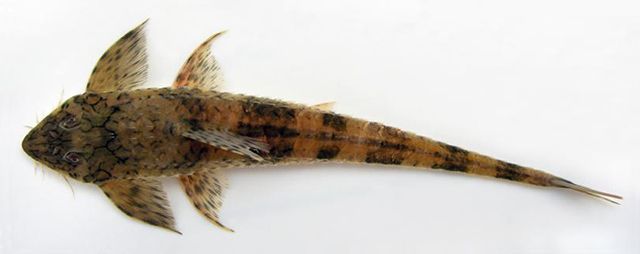| Loricariidae (Armored catfishes), subfamily: Loricariinae |
| 18.91 cm SL (male/unsexed) |
|
demersal; freshwater |
| South America: throughout the rio Paraguay basin of Bolivia, Brazil, and Paraguay, south to its confluence with the rio Paraná in Argentina. |
|
This species can be diagnosed from all congeners, except Loricaria coximensis, L. holmbergi, and L. pumila, by possessing large and tightly joined plates confined to median abdominal space between lateral abdominal plates, with pectoral girdle entirely naked or occasionally with small isolated plates near base of pectoral fin (vs. plates covering the entire median abdominal space and pectoral girdle, usually with a V-shaped anterior margin). It differs from L. pumila by having a larger adult size (13-19 cm vs. less than 8.5 cm SL), iris operculum present (vs. absent), and larger eye size (minimum orbital diameter 16.2- 19.4% vs. usually less than 13.3% of HL); from most similar species L. coximensis and L. holmbergi by having a larger adult size (13-19 cm SL vs. usually less than 13 cm SL) and larger post-ural plate length (17.0-20.3% vs. 7.4-14.2% of HL); and further distinguished from L. coximensis by having 32-33 lateral plates (vs. 28-31) (Ref. 94550). |
| Occurs in flowing water habitats ranging from small, seasonally intermittent streams (arroyos) to large permanent rivers. Collected from the following localities: repeatedly in small order streams with clear water in the upper rio Miranda drainage within the boundaries of the Parque Nacional da Serra da Bodoquena; in and above riffles at depths of 0.3-1.5 m in the Aquidaban and Tebicuary drainages; in black water at the edge of the main river channel in swift current over sand and mud substrates in the rio Negro at the southern end of the Pantanal wetlands; along the shore over substrates of sand, silt and mud, at a depth of less than 1.5 m using seine at night in the lower rio Paraná (Ref. 94550). |
|
Least Concern (LC); Date assessed: 16 November 2020 Ref. (130435)
|
| harmless |
Source and more info: www.fishbase.org. For personal, classroom, and other internal use only. Not for publication.

